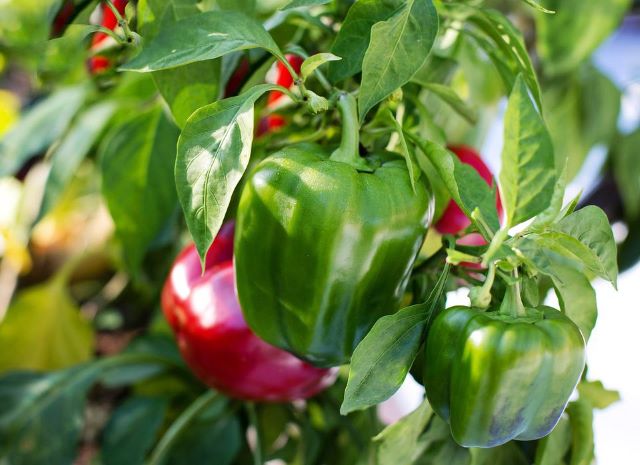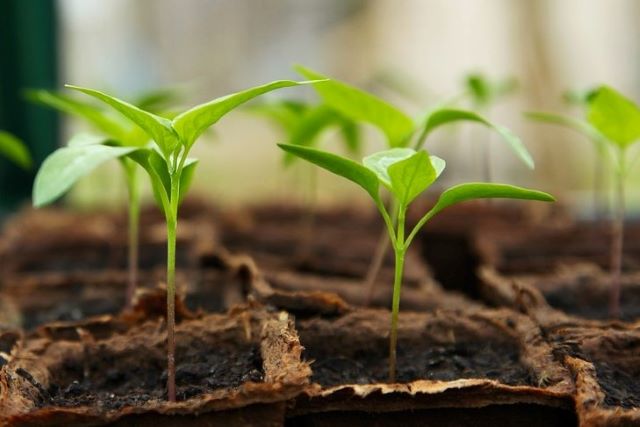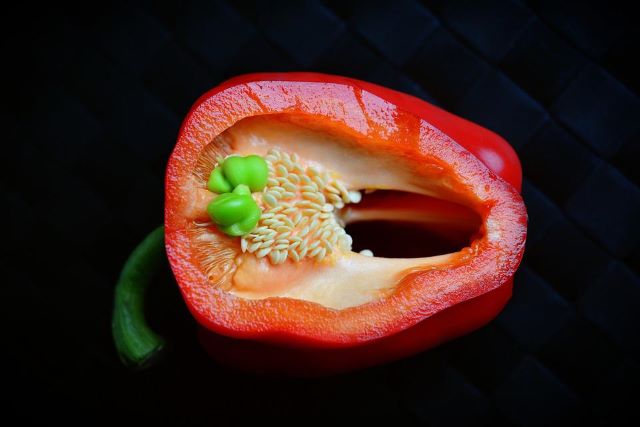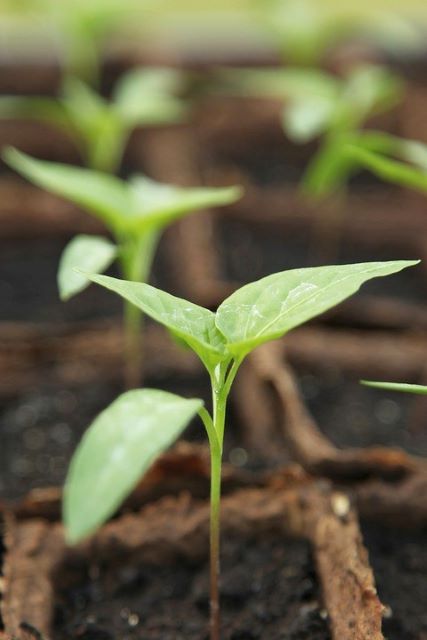When bell pepper seeds don’t sprout, it can be frustrating and disappointing. It takes care, time, and the proper conditions for bell pepper seeds to germinate (also known as capsicums). So in this post, I’ll go over what all those conditions are, and give you some tips to get your bell pepper seeds to sprout successfully.
The most common reasons bell pepper seed do not germinate is due to the temperature, soil moisture, the age of the seeds, and the growing medium.

Related: Brown Spots On Peppers | Bell Pepper Flowers But No Fruit | Why Bell Peppers Are Small
Table of Contents
- Why Bell Pepper Seeds Fail to Germinate
- 1. Keep the Soil at the Ideal Temperature to Germinate Bell Pepper Seeds
- 2. Keep the Soil Moist to Successfully Germinate Bell Pepper Seeds
- 3. Don’t Use Bell Pepper Seeds That are Too Old
- 4. Choose the Right Growing Medium for Sprouting Bell Pepper Seeds
- 5. Prepare Bell Pepper Seeds Before Planting
- 6. For Successful Seed Germination Start Bell Peppers Indoors
Why Bell Pepper Seeds Fail to Germinate
When a lot of your bell pepper seeds don’t sprout, there’s going to be a reason. So, if you provide the right conditions, you’re more likely to have successful germination.
You should also keep in mind that bell peppers sometimes take a longish time to germinate. It can take anywhere from 10-14 days for seeds to sprout. So if it’s been a couple weeks and they haven’t sprouted yet, you might just have to wait a little bit longer.
There are four common things that cause bell pepper seeds not to germinate:
- The temperature is wrong, typically too low for growing bell peppers
- There’s not enough moisture around the bell pepper seed
- The bell pepper seeds are old and not viable
- The growing medium isn’t right for bell peppers, usually being too dense
So what do you do about each of these issues? How do you get bell pepper seeds to successfully germinate? Here are some detailed tips to improve the chances of your bell peppers sprouting.

1. Keep the Soil at the Ideal Temperature to Germinate Bell Pepper Seeds
Bell pepper seeds are sensitive to temperature. They need to stay within a certain temperature range, or they’re not likely to germinate. So controlling the temperature for your bell pepper seeds is important.
The ideal temperature range for bell pepper germination is 65-75 °F (18-24 °C). If the soil temperature drops below 60 °F (15 °C), bell peppers probably won’t sprout. And while bell peppers do like heat, if the temperature rises above 90 °F (32 °C), it can also inhibit their germination.
There are lots of ways to control temperature. And because of their temperature needs, bell peppers are often germinated indoors to help control their environment.
One common way of controlling temperature is by using heating pads like this one, under the seed trays. This allows you to set a temperature and help keep the soil at the ideal warmth for bell peppers.
You can also place sprouting trays in a warm spot, like a sunny windowsill. Or you can use heat lamps. There are a lot of different ways to regulate the temperature of your bell pepper seeds, especially if growing them indoors.
2. Keep the Soil Moist to Successfully Germinate Bell Pepper Seeds
Water is vital to the germination of bell peppers. The seeds need to have enough moisture around them in order to sprout. If there isn’t moisture, they just won’t sprout.
So, it’s important to keep your bell pepper seeds well-watered. You don’t want the soil to be soggy and waterlogged, because this makes it harder for seeds to sprout. However, you do want to keep the soil consistently moist.
You can do this in a lot of ways. One, of course, is to water consistently, checking the moisture daily to ensure the soil doesn’t dry out.
You can also place a bit of plastic wrap over the seed trays. And many seed trays are also sold with hard, clear, plastic covers for this purpose. Water droplets will gather on the plastic lid, indicating the moisture levels are good and helping to keep moisture in. If you notice the water droplets starting to fade, give the soil more water.
One of my favorite things to do to ensure consistent moisture is to create self-watering planters for my seedlings. These are made using common household items, and regulate moisture levels much better than simply watering by hand. To make them even more sustainable, you can put biodegradable pots inside the water bottles, which will also make them easier to transplant.
3. Don’t Use Bell Pepper Seeds That are Too Old

When bell pepper seeds get too old, they simply don’t germinate as much. So the older a seed is, the less likely it is to germinate, which could be why your bell pepper seeds aren’t sprouting.
The generally-accepted cut-off for viable bell pepper seeds is two years. Once your seeds hit this age, they’re much less likely to sprout. So if you’re having trouble getting bell pepper seeds to germinate, think about how old your seeds are.
This means, then, that the newer your seeds are, the more likely they are to sprout. Getting younger bell pepper seeds, that have been stored more recently, will greatly increase your chance of successful germination.
You can also help control this by using your own bell pepper seeds. If you already have bell pepper plants, you can save the seeds from some of your peppers to be used next season.
I’ve also grown bell peppers with seeds from a pepper I bought at the grocery store. Just keep in mind that because of growth inhibitors and other commercial chemicals used, this doesn’t work as well as bell pepper seeds bought or harvested for the purpose of growing.
4. Choose the Right Growing Medium for Sprouting Bell Pepper Seeds

When planting bell pepper seeds, you should use a light soil mix. If the soil is too dense or heavy, it can compact around the seed, and make germination difficult.
Soils that are full of clay are not recommended for bell pepper germination — and for growing a lot of plants in general. Additionally, if the soil has a lot of rocks, stones, and pebbles, these can also get in the way of bell pepper seed germination.
I like to buy an organic seed-starting soil mix like this one, which is formulated to be light, as well as full of nutrients that are great for bell peppers. However, you can also use a standard potting mix or various other soils.
If you’re concerned about your soil being too dense, consider amending it to loosen it up. Organic matter like compost will both loosen the soil and add helpful nutrients. You can also add coco peat or very fine woodchips (even sawdust) to help lighten the soil.
You also need to consider how deep you plant your seeds. Most bell pepper seeds should be sown ¼” to ½” deep. If you plant them deeper than this, they may have trouble breaking through to the surface.
5. Prepare Bell Pepper Seeds Before Planting
A great way to boost your chances of successful bell pepper seed sprouting is by preparing your seeds before you plant them. This usually involves soaking seeds in water, and sometimes the paper towel method.
Getting bell pepper seeds wet before planting them helps a lot, because it makes sure they get a lot of moisture early on. This encourages bell pepper seeds to sprout and grow, since they know they have a good water source. So, getting them wet now will help them sprout later.
The first way you can do this is to soak the bell pepper seeds in water. Fill a bowl with warm water, not hot, and put in your bell pepper seeds. Typically, you should leave them in for a few hours, although you can leave them for longer, up to a whole day.
Alternatively, you can use the paper towel method, which can get the seeds to sprout before you even plant them. To do this, get a paper towel and a ziplock bag or other airtight container. Start by getting the paper towel wet and wringing it out. You want it to be damp, but not dripping with water.
Then, carefully lay your belll pepper seeds on the paper towel and then wrap or fold the paper towel, with the seeds in it. Finally, place the paper towel into the ziplock bag or airtight container, and leave it for a few days.
This keeps the bell pepper seeds surrounded by moisture, without being too damp.
Often, bell pepper seeds will sprout in the bag, sometimes attaching themselves to the paper towel. After a few days, you can open the bag and carefully remove the small seedlings. Sometimes the easiest thing to do is just cut a part of the paper towel. Then, transplant the bell pepper seedling into your soil, and watch as they flourish!
6. For Successful Seed Germination Start Bell Peppers Indoors
Perhaps the best tip I can give you, especially if you live in a colder region, is to start bell pepper seedlings indoors. Bell peppers need a lot of time to mature, and they don’t like the cold. So to prevent the growing season from being too short, you can start bell peppers inside.
This is how I start my seeds every year, and it works really well. I end up with tall bell pepper plants that are happily producing before the end of summer.
Typically, you want to start seeds indoors six to eight weeks before you’re going to transplant your bell pepper seedling outside, which should be a few weeks after the last frost.
Using biodegradable seed trays is one of the best ways to do this. Then, when the peppers are ready to be transplanted, you don’t have to disturb the roots, lowering the chance of stress on the plants.
When doing this, remember all the factors above. You need to control temperature, moisture, and the soil medium to help your bell pepper seeds grow.
Again, heating pads can help, or choosing a warm location. There are lots of ways to control moisture, such as using a plastic cover, or self-watering planters; not only are they efficient, but they mean you can water less often.
Remember to use younger bell pepper seeds to ensure they are viable, and make sure your soil isn’t too dense or full of heavy obstructions.
You’ll also want to consider light levels. Bell peppers don’t need light to germinate, but they will need light once they’ve sprouted. Grow lights are a great addition to an indoor garden. Not only are you giving your plants the light they need, but you can easily control how much light and how far away it is.
Be aware, though, that some grow lights give off heat. If yours do this, take that into consideration when deciding where to put your seed trays. Just as being too cold can be inhibit growth, so can being too warm.
Related: How to Start Vegetable Seedlings Under Grow Lights
Before transplanting your bell pepper seedlings, you need to prepare them for going outside. I use a fan blowing on my seedlings a couple of hours every day, to help simulate wind and encourage them to grow stronger stems.
You also need to adjust them to different light and temperature levels. I do this by moving the seedlings into a shaded area on my porch for a week, and then into full sun for a week, before I transplant them outdoors.
If you do decide to sow your bell pepper seeds directly into the ground outside, just make sure it’s warm enough. Remember, if it drops below 60 °F (15 °C), bell peppers won’t germinate. Bell peppers can take up to 90 days to reach maturity, so make sure you can plant them early enough to not get cut off by early fall frosts.
Related reading:
